国际会计准则第 21号外汇汇率变动的影响【外文翻译】
国际准则修改
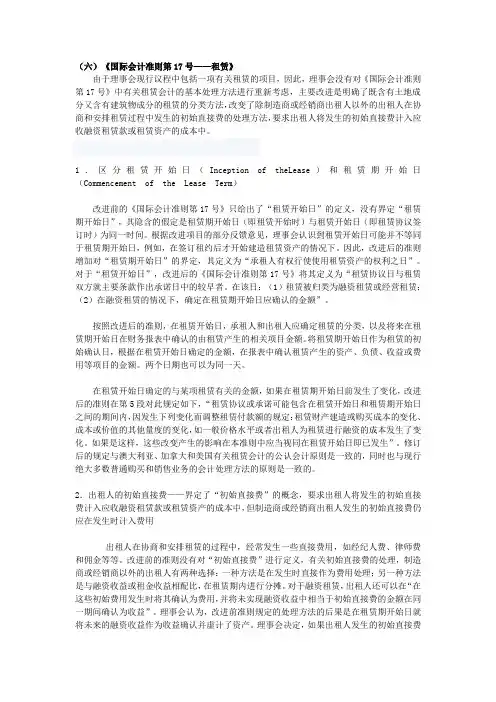
(六)《国际会计准则第17号——租赁》由于理事会现行议程中包括一项有关租赁的项目,因此,理事会没有对《国际会计准则第17号》中有关租赁会计的基本处理方法进行重新考虑,主要改进是明确了既含有土地成分又含有建筑物成分的租赁的分类方法,改变了除制造商或经销商出租人以外的出租人在协商和安排租赁过程中发生的初始直接费的处理方法,要求出租人将发生的初始直接费计入应收融资租赁款或租赁资产的成本中。
1.区分租赁开始日(Inception of theLease)和租赁期开始日(Commencement of the Lease Term)改进前的《国际会计准则第17号》只给出了“租赁开始日”的定义,没有界定“租赁期开始日”,其隐含的假定是租赁期开始日(即租赁开始时)与租赁开始日(即租赁协议签订时)为同一时间。
根据改进项目的部分反馈意见,理事会认识到租赁开始日可能并不等同于租赁期开始日,例如,在签订租约后才开始建造租赁资产的情况下。
因此,改进后的准则增加对“租赁期开始日”的界定,其定义为“承租人有权行使使用租赁资产的权利之日”。
对于“租赁开始日”,改进后的《国际会计准则第17号》将其定义为“租赁协议日与租赁双方就主要条款作出承诺日中的较早者。
在该日:(1)租赁被归类为融资租赁或经营租赁;(2)在融资租赁的情况下,确定在租赁期开始日应确认的金额”。
按照改进后的准则,在租赁开始日,承租人和出租人应确定租赁的分类,以及将来在租赁期开始日在财务报表中确认的由租赁产生的相关项目金额。
将租赁期开始日作为租赁的初始确认日,根据在租赁开始日确定的金额,在报表中确认租赁产生的资产、负债、收益或费用等项目的金额。
两个日期也可以为同一天。
在租赁开始日确定的与某项租赁有关的金额,如果在租赁期开始日前发生了变化,改进后的准则在第5段对此规定如下,“租赁协议或承诺可能包含在租赁开始日和租赁期开始日之间的期间内,因发生下列变化而调整租赁付款额的规定:租赁财产建造或购买成本的变化、成本或价值的其他量度的变化,如一般价格水平或者出租人为租赁进行融资的成本发生了变化。
《IAS21外汇汇率变动的影响》简介
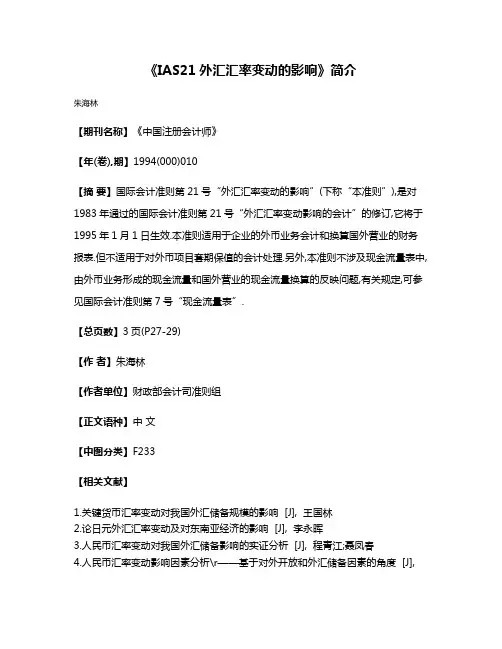
《IAS21外汇汇率变动的影响》简介
朱海林
【期刊名称】《中国注册会计师》
【年(卷),期】1994(000)010
【摘要】国际会计准则第21号“外汇汇率变动的影响”(下称“本准则”),是对1983年通过的国际会计准则第21号“外汇汇率变动影响的会计”的修订,它将于1995年1月1日生效.本准则适用于企业的外币业务会计和换算国外营业的财务报表.但不适用于对外币项目套期保值的会计处理.另外,本准则不涉及现金流量表中,由外币业务形成的现金流量和国外营业的现金流量换算的反映问题,有关规定,可参见国际会计准则第7号“现金流量表”.
【总页数】3页(P27-29)
【作者】朱海林
【作者单位】财政部会计司准则组
【正文语种】中文
【中图分类】F233
【相关文献】
1.关键货币汇率变动对我国外汇储备规模的影响 [J], 王国林
2.论日元外汇汇率变动及对东南亚经济的影响 [J], 李永晖
3.人民币汇率变动对我国外汇储备影响的实证分析 [J], 程青江;聂凤春
4.人民币汇率变动影响因素分析\r——基于对外开放和外汇储备因素的角度 [J],
张奕涵
5.人民币实际有效汇率变动对外汇储备规模影响的实证分析 [J], 张洪霞; 赵砚因版权原因,仅展示原文概要,查看原文内容请购买。
外汇汇率变动影响

汇率波动可能影响国际经济合作
03
汇率的不稳定可能引发贸易伙伴之间的经济利益冲突,影响国
际经济合作的进程。
对国际金融市场的影响
汇率波动可能引发国际金融市场动荡
汇率的大幅波动可能引发跨境资本流动和货币投机的风险,导致国际金融市场的不稳定 。
汇率波动可能影响国际货币体系
汇率的变动可能对国际货币体系产生影响,例如对储备货币的地位和汇率制度的安排等 。
外汇交易
汇率的变动对个人和机构的外汇交易有直接 影响。汇率的波动可能导致外汇交易的盈利 或亏损。对于投资者而言,了解汇率风险并 采取适当的对冲措施至关重要。
04
CATALOGUE
外汇汇率变动对经济政策的影响
对货币政策的影响
汇率变动对货币供应量
当汇率贬值时,中央银行为了维持汇率稳定,会买入外汇,从而减少国内货币供应量。 反之,汇率升值时,中央银行会卖出外汇,增加国内货币供应量。
VS
资金成本
汇率的变动可能会影响国内企业的资金成 本。例如,当本币升值时,企业可能需要 更多的外币来偿还外债,这可能增加资金 成本。相反,当本币贬值时,企业可能需 要更少的外币来偿还外债,这可能降低资 金成本。
对外汇投资的影响
外汇储备
汇率的变动对外汇储备有重要影响。当本币 贬值时,外汇储备的价值可能会减少。为了 维持外汇储备的稳定,中央银行可能需要干 预外汇市场。
CATALOGUE
外汇汇率变动对全球经济的影响
对全球贸易的影响
汇率波动可能导致国际贸易成本增加
01
当汇率变动时,进口商需要重新评估购买决策,出口
商需要调整定价策略,这都可能增加贸易成本。
汇率波动可能影响国际贸易平衡
02 汇率的升值或贬值可能影响一国的出口竞争力,从而
(精品)ias21外币汇率变动的影响2003年颁布
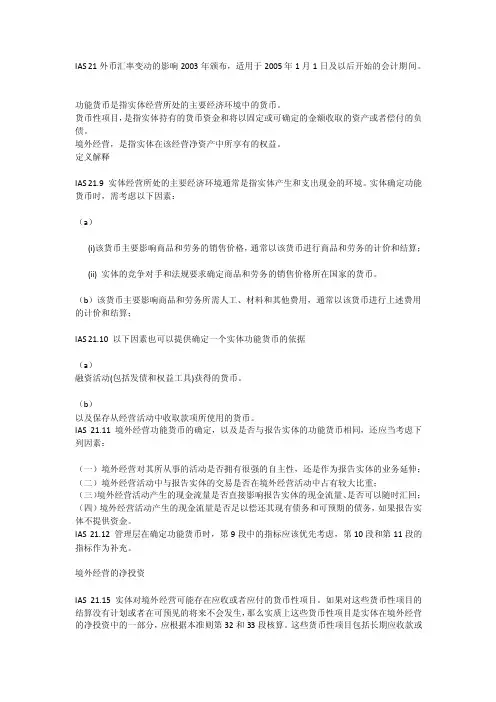
IAS 21外币汇率变动的影响2003年颁布,适用于2005年1月1日及以后开始的会计期间。
功能货币是指实体经营所处的主要经济环境中的货币。
货币性项目,是指实体持有的货币资金和将以固定或可确定的金额收取的资产或者偿付的负债。
境外经营,是指实体在该经营净资产中所享有的权益。
定义解释IAS 21.9 实体经营所处的主要经济环境通常是指实体产生和支出现金的环境。
实体确定功能货币时,需考虑以下因素:(a)(i)该货币主要影响商品和劳务的销售价格,通常以该货币进行商品和劳务的计价和结算;(ii) 实体的竞争对手和法规要求确定商品和劳务的销售价格所在国家的货币。
(b)该货币主要影响商品和劳务所需人工、材料和其他费用,通常以该货币进行上述费用的计价和结算;IAS 21.10 以下因素也可以提供确定一个实体功能货币的依据(a)融资活动(包括发债和权益工具)获得的货币。
(b)以及保存从经营活动中收取款项所使用的货币。
IAS 21.11 境外经营功能货币的确定,以及是否与报告实体的功能货币相同,还应当考虑下列因素:(一)境外经营对其所从事的活动是否拥有很强的自主性,还是作为报告实体的业务延伸;(二)境外经营活动中与报告实体的交易是否在境外经营活动中占有较大比重;(三)境外经营活动产生的现金流量是否直接影响报告实体的现金流量、是否可以随时汇回;(四)境外经营活动产生的现金流量是否足以偿还其现有债务和可预期的债务,如果报告实体不提供资金。
IAS 21.12 管理层在确定功能货币时,第9段中的指标应该优先考虑,第10段和第11段的指标作为补充。
境外经营的净投资IAS 21.15 实体对境外经营可能存在应收或者应付的货币性项目。
如果对这些货币性项目的结算没有计划或者在可预见的将来不会发生,那么实质上这些货币性项目是实体在境外经营的净投资中的一部分,应根据本准则第32和33段核算。
这些货币性项目包括长期应收款或借款,但是不报告贸易应收款和贸易应付款。
汇率变动对经济的影响
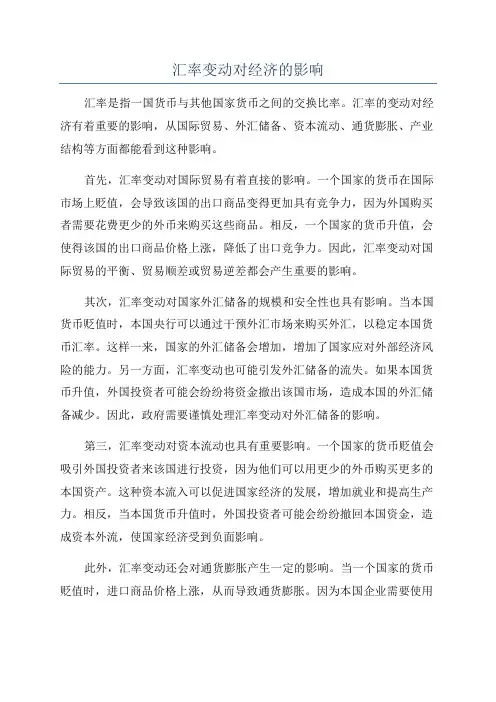
汇率变动对经济的影响汇率是指一国货币与其他国家货币之间的交换比率。
汇率的变动对经济有着重要的影响,从国际贸易、外汇储备、资本流动、通货膨胀、产业结构等方面都能看到这种影响。
首先,汇率变动对国际贸易有着直接的影响。
一个国家的货币在国际市场上贬值,会导致该国的出口商品变得更加具有竞争力,因为外国购买者需要花费更少的外币来购买这些商品。
相反,一个国家的货币升值,会使得该国的出口商品价格上涨,降低了出口竞争力。
因此,汇率变动对国际贸易的平衡、贸易顺差或贸易逆差都会产生重要的影响。
其次,汇率变动对国家外汇储备的规模和安全性也具有影响。
当本国货币贬值时,本国央行可以通过干预外汇市场来购买外汇,以稳定本国货币汇率。
这样一来,国家的外汇储备会增加,增加了国家应对外部经济风险的能力。
另一方面,汇率变动也可能引发外汇储备的流失。
如果本国货币升值,外国投资者可能会纷纷将资金撤出该国市场,造成本国的外汇储备减少。
因此,政府需要谨慎处理汇率变动对外汇储备的影响。
第三,汇率变动对资本流动也具有重要影响。
一个国家的货币贬值会吸引外国投资者来该国进行投资,因为他们可以用更少的外币购买更多的本国资产。
这种资本流入可以促进国家经济的发展,增加就业和提高生产力。
相反,当本国货币升值时,外国投资者可能会纷纷撤回本国资金,造成资本外流,使国家经济受到负面影响。
此外,汇率变动还会对通货膨胀产生一定的影响。
当一个国家的货币贬值时,进口商品价格上涨,从而导致通货膨胀。
因为本国企业需要使用更多的本国货币来购买进口商品。
反过来,一个国家的货币升值会导致进口商品价格下降,通货膨胀风险相对较低。
最后,汇率变动还有可能对产业结构产生影响。
当一个国家的货币贬值时,该国的出口商品更具有竞争力,可能会促进出口型产业的发展。
相反,当一个国家的货币升值时,该国的出口商品价格上涨,可能会导致出口型产业的衰退,从而推动本国的消费型产业发展。
综上所述,汇率的变动对经济有着重要的影响。
国际会计准则第21号--外汇汇率变动的影响
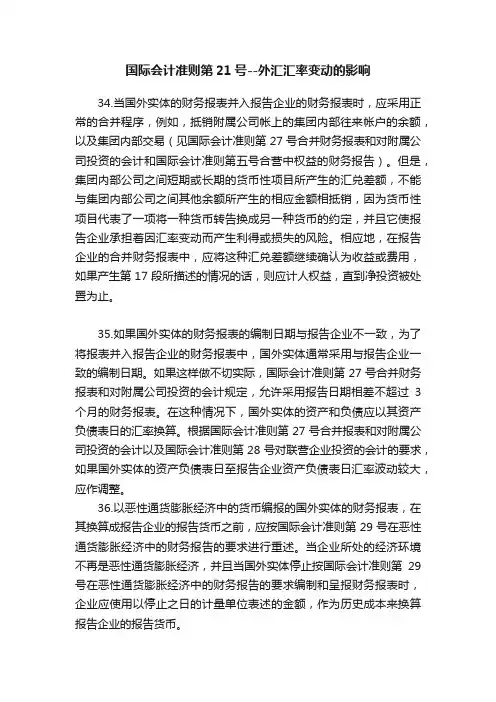
国际会计准则第21号--外汇汇率变动的影响34.当国外实体的财务报表并入报告企业的财务报表时,应采用正常的合并程序,例如,抵销附属公司帐上的集团内部往来帐户的余额,以及集团内部交易(见国际会计准则第27号合并财务报表和对附属公司投资的会计和国际会计准则第五号合营中权益的财务报告)。
但是,集团内部公司之间短期或长期的货币性项目所产生的汇兑差额,不能与集团内部公司之间其他余额所产生的相应金额相抵销,因为货币性项目代表了一项将一种货币转告换成另一种货币的约定,并且它使报告企业承担着因汇率变动而产生利得或损失的风险。
相应地,在报告企业的合并财务报表中,应将这种汇兑差额继续确认为收益或费用,如果产生第17段所描述的情况的话,则应计人权益,直到净投资被处置为止。
35.如果国外实体的财务报表的编制日期与报告企业不一致,为了将报表并入报告企业的财务报表中,国外实体通常采用与报告企业一致的编制日期。
如果这样做不切实际,国际会计准则第27号合并财务报表和对附属公司投资的会计规定,允许采用报告日期相差不超过3个月的财务报表。
在这种情况下,国外实体的资产和负债应以其资产负债表日的汇率换算。
根据国际会计准则第27号合并报表和对附属公司投资的会计以及国际会计准则第28号对联营企业投资的会计的要求,如果国外实体的资产负债表日至报告企业资产负债表日汇率波动较大,应作调整。
36.以恶性通货膨胀经济中的货币编报的国外实体的财务报表,在其换算成报告企业的报告货币之前,应按国际会计准则第29号在恶性通货膨胀经济中的财务报告的要求进行重述。
当企业所处的经济环境不再是恶性通货膨胀经济,并且当国外实体停止按国际会计准则第29号在恶性通货膨胀经济中的财务报告的要求编制和呈报财务报表时,企业应使用以停止之日的计量单位表述的金额,作为历史成本来换算报告企业的报告货币。
国外实体的处置37.在处置国外实体时,已递延并且与该国外实体有关的汇兑差额的累计金额,应在确认处置的利得或损失的当期确认为收益或费用。
国际会计准则第21号--外汇汇率变动的影响
国际会计准则第21号--外汇汇率变动的影响(1993年12月修订)目的企业可以用两种方式从事对外的活动。
它可能具有用外币计价的交易活动,也可能具有国外的经营。
为了使外币交易和国外经营在企业财务报表中得到反映,交易必须以企业的报告货币来表述,国外经营的财务报表也必须换算成企业的报告货币。
在对外币交易和国外经营的会计处理中,主要问题是决定使用何种汇率以及如何在财务报表中确认汇率变动的影响。
范围1.本号准则适用于:(1)对外币计价的交易的会计处理;和(2)通过合并、比例合并或权益法对已包括在企业的财务报表中的国外经营的财务报表进行换算。
2.本号准则不涉及对外币项目进行长期保值所作的会计处理,但对国外实体投资净额进行套期保值而产生的外币负债所引起汇兑差额的分类,则可以例外。
套期保值会计的其他方面,包括运用套期保值会计的标准,将在国际会计准则第32号金融工具中涉及。
3.本号准则替代于1983年批准的国际会计准则第21号外汇汇率变动影响的会计.4.本号准则不对企业呈报财务报表所使用的货币作出特别的规定。
然而,企业通常应采用其所在国的货币作为报告货币。
如果企业采用不同的货币,本号准则要求揭示使用该种货币的原因。
本号准则还要求揭示报告货币发生任何变更的原因。
5.本号准则不涉及企业为了方便那些习惯使用另一种货币的读者或类似目的,而将财务报表由报告货币再换算为另一种货币的情况。
6.本号准则不涉及在现金流量表中,对由外币交易形成的现金流量和国外经营的现金流量的换算进行呈报的问题(见国际会计准则第7号现金流量表);定义7.本号准则所使用的下列术语,具有特定的含义:国外经营,是指活动基地或活动范围在报告企业所在国以外的国家的报告企业的附属公司、联营企、合营企业或分支机构。
国外实体,是指其活动不属于报告企业活动有机组成部分的那种国外经营。
报告货币,是指呈报财务报表所采用的货币。
外币,是指企业报告货币以外的货币。
汇率,是指两种货币交换的比率。
国际会计准则第21号
国际会计准则第21号--外汇汇率变动的影响国际会计准则第21号(1993年12月修订)目的企业可以用两种方式从事对外的活动。
它可能具有用外币计价的交易活动,也可能具有国外的经营。
为了使外币交易和国外经营在企业财务报表中得到反映,交易必须以企业的报告货币来表述,国外经营的财务报表也必须换算成企业的报告货币。
在对外币交易和国外经营的会计处理中,主要问题是决定使用何种汇率以及如何在财务报表中确认汇率变动的影响。
范围1.本号准则适用于:(1)对外币计价的交易的会计处理;和(2)通过合并、比例合并或权益法对已包括在企业的财务报表中的国外经营的财务报表进行换算。
2.本号准则不涉及对外币项目进行长期保值所作的会计处理,但对国外实体投资净额进行套期保值而产生的外币负债所引起汇兑差额的分类,则可以例外。
套期保值会计的其他方面,包括运用套期保值会计的标准,将在国际会计准则第32号金融工具中涉及。
3.本号准则替代于1983年批准的国际会计准则第21号外汇汇率变动影响的会计.4.本号准则不对企业呈报财务报表所使用的货币作出特别的规定。
然而,企业通常应采用其所在国的货币作为报告货币。
如果企业采用不同的货币,本号准则要求揭示使用该种货币的原因。
本号准则还要求揭示报告货币发生任何变更的原因。
5.本号准则不涉及企业为了方便那些习惯使用另一种货币的读者或类似目的,而将财务报表由报告货币再换算为另一种货币的情况。
6.本号准则不涉及在现金流量表中,对由外币交易形成的现金流量和国外经营的现金流量的换算进行呈报的问题(见国际会计准则第7号现金流量表);定义7.本号准则所使用的下列术语,具有特定的含义:国外经营,是指活动基地或活动范围在报告企业所在国以外的国家的报告企业的附属公司、联营企、合营企业或分支机构。
国外实体,是指其活动不属于报告企业活动有机组成部分的那种国外经营。
报告货币,是指呈报财务报表所采用的货币。
外币,是指企业报告货币以外的货币。
国际会计准则第21号-——外汇汇率变动的影响
《国际会计准则第21号——外汇汇率变动的影响》(1993年12月修订)目的企业可以用两种方式从事对外的活动。
它可能具有用外币计价的交易活动,也可能具有国外的经营。
为了使外币交易和国外经营在企业财务报表中得到反映,交易必须以企业的报告货币来表述,国外经营的财务报表也必须换算成企业的报告货币。
在对外币交易和国外经营的会计处理中,主要问题是决定使用何种汇率以及如何在财务报表中确认汇率变动的影响。
范围1.本号准则适用于:(1)对外币计价的交易的会计处理;和(2)通过合并、比例合并或权益法对已包括在企业的财务报表中的国外经营的财务报表进行换算。
2.本号准则不涉及对外币项目进行长期保值所作的会计处理,但对国外实体投资净额进行套期保值而产生的外币负债所引起汇兑差额的分类,则可以例外。
套期保值会计的其他方面,包括运用套期保值会计的标准,将在国际会计准则第32号“金融工具”中涉及。
3.本号准则替代于1983年批准的国际会计准则第21号“外汇汇率变动影响的会计”。
4.本号准则不对企业呈报财务报表所使用的货币作出特别的规定。
然而,企业通常应采用其所在国的货币作为报告货币。
如果企业采用不同的货币,本号准则要求揭示使用该种货币的原因。
本号准则还要求揭示报告货币发生任何变更的原因。
5.本号准则不涉及企业为了方便那些习惯使用另一种货币的读者或类似目的,而将财务报表由报告货币再换算为另一种货币的情况。
6.本号准则不涉及在现金流量表中,对由外币交易形成的现金流量和国外经营的现金流量的换算进行呈报的问题(见国际会计准则第7号“现金流量表”);定义7.本号准则所使用的下列术语,具有特定的含义:国外经营,是指活动基地或活动范围在报告企业所在国以外的国家的报告企业的附属公司、联营企业、合营企业或分支机构。
国外实体,是指其活动不属于报告企业活动有机组成部分的那种国外经营。
报告货币,是指呈报财务报表所采用的货币。
外币,是指企业报告货币以外的货币。
外币折算会计准则的国际比较
外币折算会计准则的国际比较作者:项军红来源:《决策与信息·下旬刊》2016年第07期【摘要】外币折算是财务会计的三大难题之一,我国对外币折算准则的制定工作最早是在1995年,财政部提交了具体会计准则讨论稿《外币折算》,但是后来并没有发布此准则。
2006年2月15日,财政部发布了《企业会计准则———基本准则》和《企业会计准则第19号——外币折算》等38项具体准则,对外币折算的确认、计量、披露等做出了详细的规范。
本文对我国外币折算会计准则与《国际会计准则第21号——汇率变动的影响》进行比较,以期能更好地理解和执行新会计准则,同时,也希望对我国会计准则的不断完善和国际趋同有所启示。
【关键词】外币折算;汇率变动影响;国际比较;例解由于改革开放和外资利用的增加,我国进出口贸易和对外经济合作有了极大发展,外币核算业务量猛增。
为此,我国于2006年2月首次发布了《企业会计准则第19号——外币折算》(以下称新外币折算会计准则)。
本文对我国外币折算会计准则与《国际会计准则第21号——汇率变动的影响》进行比较,以期能更好地理解和执行新会计准则,同时,也希望对我国会计准则的不断完善和国际趋同有所启示。
一、准则范围的比较(一)新外币折算会计准则的规定。
新外币折算会计准则第一条规定:为了规范外币交易的会计处理、外币财务报表的折算和相关信息的披露,根据《企业会计准则——基本准则》,制定本准则。
我国并没有明确说明外币折算准则的适用范围,只在第三条规定以下几种情况不适用本准则:(1)外币项目的套期,适用《企业会计准则第 24 号——套期保值》;(2)与购建固定资产相关的外币借款产生的汇兑差额,适用《企业会计准则第17号——借款费用》;(3)现金流量表中的外币折算,适用《企业会计准则第31号——现金流量表》。
(二)国际会计准则的规定。
《国际会计准则第21号-外汇汇率变动的影响》(以下简称国际会计准则)则对其适用范围进行了明确的规定:该准则适用于:(1)对外币计价的交易的会计处理;和(2)通过合并、比例合并或权益法对已包括在企业的财务报表中的国外经营的财务报表进行换算。
- 1、下载文档前请自行甄别文档内容的完整性,平台不提供额外的编辑、内容补充、找答案等附加服务。
- 2、"仅部分预览"的文档,不可在线预览部分如存在完整性等问题,可反馈申请退款(可完整预览的文档不适用该条件!)。
- 3、如文档侵犯您的权益,请联系客服反馈,我们会尽快为您处理(人工客服工作时间:9:00-18:30)。
本科毕业论文(设计)外文翻译题目外币报表折算方法分析及中国的选择初探专业会计学外文题目Effect of Changes in Exchage Rates of Foreign Currencies 外文出处International Accounting Standard No 21 (IAS 21)外文作者International Accounting Standards Board原文:International Accounting Standard No 2 (IAS 2)Effect of changes in exchange rates of foreign currenciesObjectiveAn institution may conduct business abroad in two different ways. You can make transactions in foreign currency or may have business abroad. In addition, the entity may file its financial statements in a foreign currency. The purpose of this rule is to prescribe how they are incorporated in the financial statements of an entity, foreign currency transactions and business abroad, and how to convert the financial statements to the presentation currency of choice.The main problems that arise are the type or types of change to use and how to report on the effects of changes in exchange rates within the financial statements.DefinitionsOne group is the group formed by the parent and all its subsidiaries.Net investment in a foreign operation is the amount that corresponds to the participation of the entity that submitted their financial statements in the net assets of that business.Foreign currency (or currency) is any currency other than the functional currency of the entity.Functional currency is the currency of the primary economic environment in which the entity operates.Presentation currency is the currency in which the financial statements are presented.Business abroad is an entity dependent partner, joint venture or branch of the reporting entity, whose activities are based or carried out in a country or a currency different from those of the reporting entity.Currency monetary items are kept in cash and assets and liabilities to be received or paid by a fixed or determinable amount of monetary units.Exchange rate is the ratio of exchange between two currencies.End exchange rate is the rate of existing cash on the balance sheet date.Exchange rate spot is the exchange rate used in transactions with immediate delivery.Fair value is the amount for which an asset could be exchanged, canceled or a liability,among stakeholders and duly informed in a transaction conducted at arm's length.Initial Recognition1. A foreign currency transaction is any transaction whose value is called or requires winding up in a foreign currency, including those in which the entity:(a) buys or sells goods or services whose price is denominated in a foreign currency;(b) lends or borrows funds, if the amounts are set to charge or pay in a foreign currency(c) acquires or disposes provides another avenue for assets or liabilities incurred or liquidation, provided that these operations are denominated in foreign currencies.2. Any foreign currency transaction is recorded at the time of its initial recognition,using the functional currency, by applying to the amount in foreign currency exchange spot at the date of the transaction between the functional currency and foreign currency.The date of the transaction is the date on which the transaction meets the conditions for recognition in accordance with International Financial Reporting Standards. For practical reasons, often using an exchange rate closer to existing at the time of the transaction, for example, may be used for weekly or monthly average rate for all transactions that take place at that time In each of the classes of foreign currency used by the entity.However, it is not appropriate to use average rates if during the interval, the changes have fluctuated significantly.Financial information on the dates of the balance sheets post3. At each balance sheet date:(a) monetary items in foreign currencies are converted using the exchange rate of closure;(b) the non-monetary foreign currency being valued in terms of historical cost, will be converted using the exchange rate on the date of the transaction; and(c) the non-monetary foreign currency being valued at fair value, will be converted using the exchange rates of the date it was determined that fair value.4. To determine the amount of an item is taken into account, in addition, other rules that apply. For example, tangible assets can be valued in terms of historical cost or revalued amount, in accordance with IAS 16 Property, plant and equipment. Regardless of whether it has determined the amount by using the historical cost or revalued amount,provided that this amount has been established in foreign currency is converted to the functional currency using the rules set out in this Standard.Recognition of exchange differences5.Exchange differences that arise in the settlement of monetary items, or to convert monetary items at rates different from those used for its initial recognition, have already occurred during the year or in previous financial statements, are recognized in the outcome of year in which they appear.See a difference when you have change monetary items as a result of a transaction in foreign currency, and there is a change in the exchange rate between the date of the transaction and the settlement date. When the transaction is settled in the same year in which they occurred, the entire exchange difference will be recognized in that period.However, when the transaction is settled in a later period, the exchange difference recognized in each period, until the settlement date, will be determined from the change that has occurred in the exchange rate for each year. When recognized directly in equity gain or loss on a non-monetary, any exchange difference, including in such losses or gains were also recognized directly in equity. By contrast, when the gain or loss on a non-monetary recognition in profit or loss, any exchange difference, including in such losses or gains, was also recognized in profit or loss.6. Exchange differences arising on a monetary item that forms part of the netinvestment in a business of the foreign entity, are recognized in profit or loss of the separate financial statements of the reporting entity or in the separate financial statements of business abroad, as appropriate. Financial statements containing the business abroad and the reporting entity (for example,the consolidated financial statements if the business abroad is a dependent), such exchange differences are recognized initially as a separate component of equity,and subsequently recognized in the outcome when it becomes available or disposed of by other means business abroad.When a monetary item is part of the net investment, carried out by the reporting entity in a foreign operation, and is denominated in the functional currency of the reporting entity,an exchange difference arises in the separate financial statements of the business abroad.When the entity bears its records and ledgers in a currency other than their functional currency and proceed to prepare their financial statements, will convert all amounts to the functional currency, as set out in paragraphs 1 to 26.As a result, will produce the same amounts, in terms of functional currency, which would have been earned if the items were originally recorded in the functional currency. For example, monetary items are translated into the functional currency using the exchange rates of closure, and nonmonetary items which are valued at historical cost, will be converted using the exchange rate at the date of the transaction that created its appreciation.7. The results and financial position of an entity whose functional currency is not in accordance with the currency of a hyperinflationary economy, translated into the presentation currency, should it be different, using the following procedures:(a) the assets and liabilities of each balance sheet presented (i.e., including comparative figures), will be converted at the rate of closure on the date of the corresponding stock;(b) revenue and expenses for each profit and loss accounts (i.e., including comparative figures), will become the exchange rates at the date of each transaction; and(c) all exchange differences arising out of this, it is recognized as a separate component of equity.8. Often, for the conversion of items of income and expenditure, is used for practical purposes an approximate rate, representative of changes in the dates of transactions,such as the average exchange rate of the period. However, when exchange rates have changed significantly, it is inappropriate to use the average rate for the period.9. Exchange differences referred to in paragraph (c) of paragraph 39 are listed by:(a) The conversion of expenditure and revenue to the exchange rates of the dates oftransactions, and of the assets and liabilities at the rate of closure. These differencesappear to change both the expenditure items and revenue recognized in the results, as recognized by the directly in equity.(b) Conversion of assets and liabilities to an early Net-end exchange rate that is different from the type used in the previous closing. Such exchange differences are not recognized in profit or loss because of the variations in exchange rates have little or no direct effect on cash flows arising from current and future activities. When the above exchange differences relating to a business abroad that while consolidating, is not involved in its entirety, the cumulative exchange differences arising from the conversion that is attributable to the minority stake, will be allocated to it and be recognized as part of the minority interest in the consolidated balance sheet.10. When the entity's functional currency is that of a hyperinflationary economy, it will restate its financial statements before implementing the conversion method set out in paragraph 42, according to IAS 29 Financial reporting in hyperinflationary economies, except the comparative figures, in the case of conversion to the currency of a hyperinflationary economy.When the economy in question ceases to be hyperinflationary and the entity ceases to restate its financial statements in accordance with IAS 29, used as the historic costs to be converted to the presentation currency, the amounts restated according to the level of prices on the date that the entity ceased to do this restatement.11. When converting to a presentation currency, the results and financial position of a foreign operation, as a preliminary step to their inclusion in the financial statements of the reporting entity, whether through consolidation, or using the proportional consolidation method of Participation will apply paragraphs 45 to 47, in addition to the provisions of paragraphs 38 to 10.The incorporation of the results and financial position of a foreign operation to the reporting entity will follow the normal procedures of consolidation, such as the elimination of intra-group transactions and balances of a dependent (see IAS 27 States Consolidated and separate financial and IAS 31 Interests in joint ventures). However, an asset (or liability) intragroup money, either short or long term, it may not be eliminated against the corresponding liability (or asset) Intra, without showing the results of changes in exchange rates within the states Consolidated Financial. This is because the monetary item represents a commitment to convert one currency into another, which exposes the reporting entity at a loss or gain on exchange fluctuations between the currencies. In line with this, in the consolidated financial statements of the reporting entity, the exchange difference should continue to be recognized in profit or loss, or, if they arise from the circumstances described in paragraph 32, is classified as a component of equity until the disposition or disposal by other means business abroad.12. When the financial statements of business abroad and the reporting entity are referred to different dates, he often produces additional financial statements with the same date as this one. When it is not, IAS 27 allows the use of different dates of submission, provided that the difference is not greater than three months, and have performed the appropriate adjustments to reflect the effects of significant transactions and other events that occurred between the dates reference. In this case, the assets and liabilities of the business abroad will be converted at the rate of the balance sheet date business abroad.It was also carried out the appropriate adjustments for significant variations in exchange rates until the balance sheet date of the reporting entity, in accordance with IAS 27.Disposition or disposal by other means of a foreign13. To alienate or otherwise dispose of a foreign operation, exchange differences deferred as a component of shareholders' equity, related to that business abroad, be recognized in the results at the same time they recognize the outcome of the alienation or disposition.It may have all or part of their participation in a business abroad through the sale,liquidation, recovery of capital contributed or neglect. The receipt of a dividend will be part of this provision only if it constitutes a recovery in investment, for example when it is paid from income in prior years to the acquisition. In the case of disposal or partial disposal, only included in the result of the exercise, the proportionate share of the difference in accumulated corresponding conversion. The correction of the value of a business abroad will not constitute a sale or partial disposal. Accordingly, at the time of accounting for this correction, shall not be recognized in profit or loss accrued no difference conversion.Source:(Excerpt from)International Accounting Standard No 21 (IAS 21),International Accounting Standards Board 1993译文:国际会计准则第21号外汇汇率变动的影响(1993年12月修订)目的企业可以用两种方式从事对外的活动。
